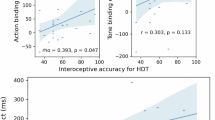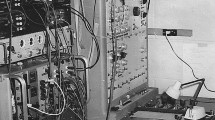Abstract
The evidence regarding specific cardiac perception and discrimination, and its relationship to voluntary cardiac control, is critically reviewed. Studies are considered in three sections, depending on the method used to assess cardiac perception: questionnaire assessment, discrimination procedures, and heartbeat tracking. The heartbeat tracking procedure would appear to suffer least from interpretative difficulties. Recommendations are made regarding the style of analysis used to assess heartbeat perception in such tracking tasks.
Similar content being viewed by others
References
Bergman, J. S., & Johnson, H. J. Effects of instructional set and autonomic perception on cardiac control.Psychophysiology 1971,8 180–190.
Blanchard, E. B., Young, L. D., & McLeod, P. Awareness of heart activity and self-control of heart rate.Psychophysiology 1972,9 63–68.
Blankstein, K. R. Note on relation of autonomic perception to voluntary control of heart rate.Perceptual and Motor Skills 1975,40 533–534.
Blankstein, K. R., & Egner, K. Effects of trait anxiety on voluntary heart rate control and subjective tenseness.Psychophysiology 1974,11 241–242. (Abstract)
Box, G., & Jenkins, G.Time series analysis. San Francisco: Holden-Day, 1970.
Brener, J. A general model of voluntary control applied to the phenomena of learned cardiovascular change. In P. A. Obrist, A. H. Black, J. Brener, & L. V. DiCara (Eds.),Cardiovascular psychophysiology. Chicago: Aldine-Atherton, 1974. (a)
Brener, J. Factors influencing the specificity of voluntary cardiovascular change. In L. V. DiCara (Ed.),Limbic and autonomic nervous systems research. New York: Plenum, 1974. (b)
Brener, J. Visceral perception. In J. Beatty & J. Legewie (Eds.),Biofeedback and behavior. New York: Plenum, 1977.
Brener, J., & Jones, J. M. Interoceptive discrimination in intact humans: Detection of cardiac activity.Physiology and Behavior 1974,13 763–767.
Clemens, W. J.Heart beat discrimination and the learning and transfer of voluntary heart rate control. Paper presented at the annual meeting of the Southeastern Psychological Association, New Orleans, Louisiana, March 1976. (a)
Clemens, W. J.Procedures for studying the discrimination of heart beats. Paper presented at the annual meeting of the Society for Psychophysiological Research, San Diego, California, October 1976. (b)
Clemens, W. J., & MacDonald, D. F.The relationship between heart beat discrimination and heart rate control. Paper presented at the annual meeting of the Society for Psychophysiological Research, Toronto, October 1975.
Donelson, F. E.Discrimination and control of human heart rate. Unpublished doctoral dissertation, Cornell University, 1966.
Engel, B. T. Operant conditioning of cardiac functioning: A status report.Psychophysiology 1972,9 161–177.
Epstein, L. H., & Stein, D. B. Feedback-influenced heart-rate discrimination.Journal of Abnormal Psychology 1974,83 585–588.
Fotopolous, S.Locus of control and the voluntary control of heart rate. Paper presented at the Annual Meeting of the Biofeedback Research Society, New Orleans, 1970.
Gatchel, R. J. Frequency of feedback and learned heart rate control.Journal of Experimental Psychology 1974,103 274–283.
Gatchel, R. J. Locus of control and voluntary heart rate change.Journal of Personality Assessment 1975,39 634–638.
James, W.Principles of psychology. New York: Holt, 1890.
Johnson, D. Criterion level and instructional effects in the voluntary control of heart rate.Biological Psychology 1976,4 1–17.
Kleinman, R. A., & Brener, J.The effects of training in heartbeat discrimination upon the subsequent development of learned heart rate control. Unpublished manuscript, University of Tennessee, 1970. (Some of the details of this study are cited in Brener, J. A general model of voluntary control applied to the phenomena of learned cardiovascular change. In P. A. Obrist, A. H. Black, J. Brener, & L. V. DiCara (Eds.),Cardiovascular psychophysiology. Chicago: Aldine-Atherton, 1974.)
Lang, P. J., & Twentyman, C. T. Learning to control heart rate: Binary vs. analogue feedback.Psychophysiology 1974,11 616–629.
Mandler, G., & Kahn, M. Discrimination of changes in heart rates: Two unsuccessful attempts.Journal for the Experimental Analysis of Behaviour 1960,3 21–25.
Mandler, G., & Kremen, I. Autonomic feedback: A correlation study.Journal of Personality 1958,26 388–399.
Mandler, G., Mandler, J. M., & Uviller, E. T. Autonomic feedback: The perception of autonomic activity.Journal of Abnormal and Social Psychology 1958,56 367–373.
McCanne, T. R., & Sandman, C. A. Proprioceptive awareness, information about response-reinforcement contingencies and operant heart-rate control.Physiological Psychology 1976,4 369–375.
McFarland, R. A. Heart rate perception and heart rate control.Psychophysiology 1975,12 402–405.
McFarland, R. A., & Campbell, C. Precise heart rate control and heart rate perception.Perceptual and Motor Skills 1975,41 730.
Obrist, P. A., Galosy, R. A., Lawler, J. E., Gaebelein, C. J., Howard, J. L., & Shanks, E. M. Operant conditioning of heart rate: Somatic correlates.Psychophysiology 1975,12 445–455.
Ray, W. J. The relationship of locus of control, self-report measures, and feedback to the voluntary control of heart rate.Psychophysiology 1974,11 527–534.
Ray, W. J., & Lamb, S. B. Locus of control and the voluntary control of heart rate.Psychosomatic Medicine 1974,36 180–182.
Rotter, J. B. Generalized expectancies for internal versus external control of reinforcement.Psychological Monographs 1966,80 1–28.
Sirota, A. D., Schwartz, G. E., & Shapiro, D. Voluntary control of human heart rate: Effect on reaction to aversive stimulation.Journal of Abnormal Psychology 1974,83 261–267.
Sirota, A. D., Schwartz, G. E., & Shapiro, D. Voluntary control of human heart rate: Effect on reaction to aversive stimulation: A replication and extension.Journal of Abnormal Psychology 1976,85 473–477.
Whitehead, W. E., Drescher, V. M., & Blackwell, B.Lack of relationship between autonomic perception questionnaire scores and actual sensitivity for perceiving one's heart beat. Paper presented at the annual meeting of the Society for Psychophysiological Research, Toronto, October 1975.
Whitehead, W. E., Drescher, V. M., & Blackwell, B.Rate of learning to differentially control heart rate is negatively correlated with subjective awareness of heart beat. Paper presented at the annual meeting of the Biofeedback Research Society, March 1976.
Whitehead, W. E., Drescher, V. M., Heiman, P., & Blackwell, B.Heart Rate control is unrelated to heart beat perception. Unpublished manuscript, University of Cincinnati, 1976.
Author information
Authors and Affiliations
Rights and permissions
About this article
Cite this article
Carroll, D. Cardiac perception and cardiac control. Biofeedback and Self-Regulation 2, 349–369 (1977). https://doi.org/10.1007/BF00998622
Received:
Issue Date:
DOI: https://doi.org/10.1007/BF00998622




